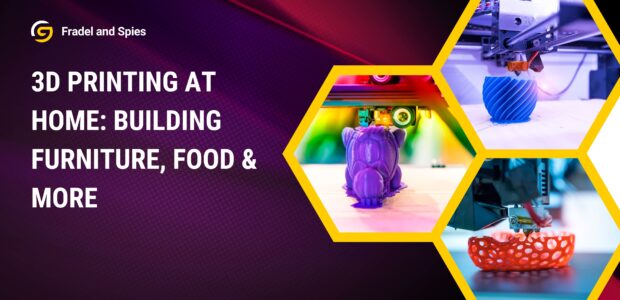3D Printing at Home: Building Furniture, Food & More
Once limited to industrial labs and high-tech startups, 3D printing has officially entered the home. In 2025, it’s no longer science fiction to print your own chair, custom kitchen tools, or even a slice of pizza—right from your living room. Affordable printers, open-source designs, and accessible materials have made 3D printing a game-changer for creativity, sustainability, and convenience.
This blog explores how home users are harnessing 3D printing to customise their spaces, reduce waste, save money, and even rethink how we eat.
🪑 3D-Printed Furniture: Custom Comfort, On Demand
Imagine designing your own nightstand or dining chair, tailored to your space and style, then printing it out within hours. That’s what thousands of homeowners are doing in 2025.
With durable filaments made from recycled plastic, wood composites, and even biodegradable materials, people are creating furniture pieces that are:
-
Custom-sized to fit small apartments or awkward corners.
-
Designed for easy assembly (no screws needed).
-
Modular, meaning you can reprint parts if anything breaks.
Open-source platforms like Thingiverse and MyMiniFactory offer thousands of free furniture blueprints, while advanced software lets users design from scratch.
🍕 From Pasta to Pizza: 3D-Printed Food Is Real
Yes, food. 3D printing is now edible.
Specialised food printers are gaining popularity for printing pancakes, chocolates, pasta shapes, and even pizza bases. These machines use pureed ingredients or dough-like substances, extruding them into shapes and cooking them instantly (or prepping them for baking).
Benefits of 3D food printing include:
-
Precise nutrition control (ideal for diabetics, athletes, or elderly care).
-
Creative plating and food presentation.
-
Zero-waste meals (print only what you’ll eat).
Although still a novelty for some households, it’s becoming more common in modern kitchens, especially in urban and high-tech homes.
🛠️ Practical Home Tools and Everyday Items
Need a phone holder? A missing shelf bracket? A unique planter for your succulents?
In 2025, people are skipping the trip to the store and printing these items at home. The flexibility of 3D printing means you can:
-
Print replacement parts for broken gadgets.
-
Create custom tools (e.g. spanners, clamps).
-
Make storage solutions like drawer dividers and cable organisers.
It’s DIY on steroids, with endless design possibilities and rapid prototyping. Hobbyists and tinkerers are building everything from robot arms to drone frames in home workshops.
🌍 The Sustainability Advantage
3D printing at home isn’t just convenient—it’s also more eco-conscious. Many home printers now support recyclable filaments and biodegradable PLA plastics. Instead of buying mass-produced goods made halfway across the world, people are:
-
Printing what they need, when they need it.
-
Using locally recycled plastic spools.
-
Reducing packaging and shipping waste.
It aligns with the zero-waste movement and appeals to conscious consumers looking to cut their environmental footprint.
🎓 Learning, Creativity, and Empowerment
For students, designers, and creators, 3D printing is a learning tool that encourages experimentation and design thinking. It’s used in:
-
Homeschooling (to teach engineering and spatial thinking).
-
Art and model-making.
-
Prototype development for aspiring entrepreneurs.
Children are printing science models. Teenagers are building drone parts. Creators are launching Etsy shops with printed jewellery, vases, and collectibles.
The accessibility of 3D printing is giving rise to a new generation of at-home inventors.
⚠️ Challenges and Considerations
While exciting, 3D printing at home comes with limitations:
-
Print time can be long for large objects.
-
Design software may have a learning curve.
-
Not all materials are food-safe or structurally strong.
Still, innovation continues to reduce these barriers. With AI-assisted design and plug-and-play printers, more people are adopting the tech every year.
🔮 What’s Next?
In the next five years, expect to see:
-
Cheaper multi-material printers for the home.
-
Improved speed and resolution.
-
Integration with smart home systems.
-
More local recycling hubs for filament reuse.
3D printing will soon feel as ordinary as using a microwave—another tool for personalisation and self-reliance.
💬 Final Thoughts
3D printing at home is more than a tech trend—it’s a lifestyle shift. It empowers individuals to create instead of consume, solve problems creatively, and live more sustainably. Whether you’re printing furniture, food, or fun, the future is quite literally in your hands.


